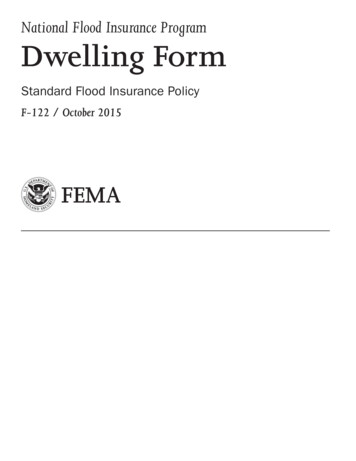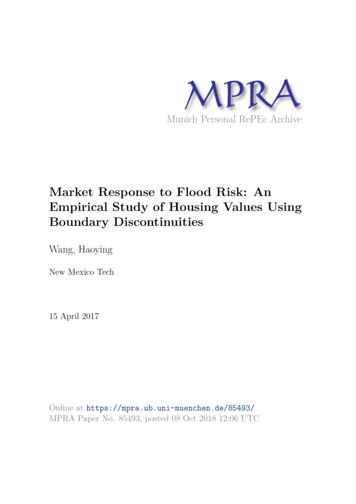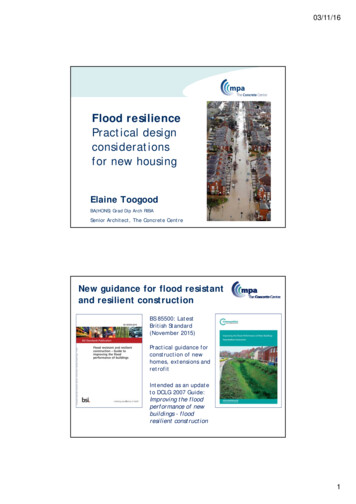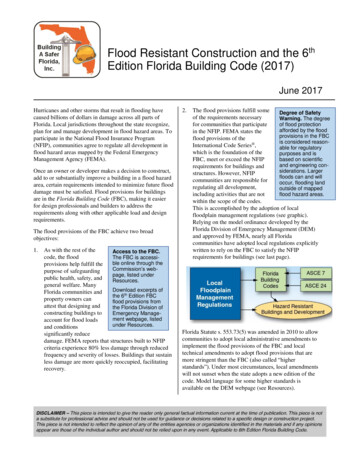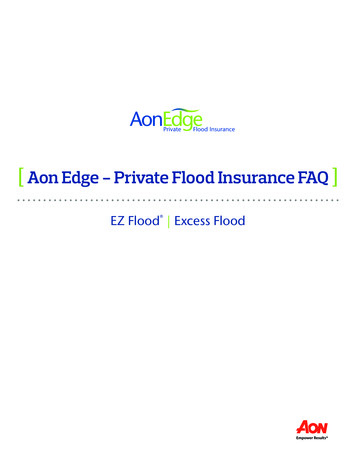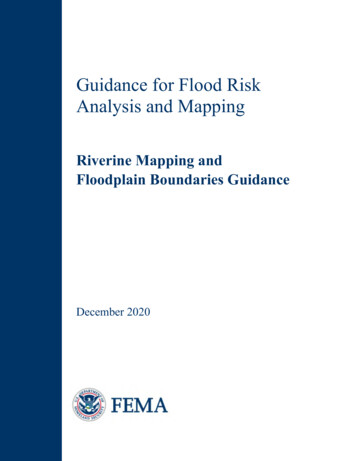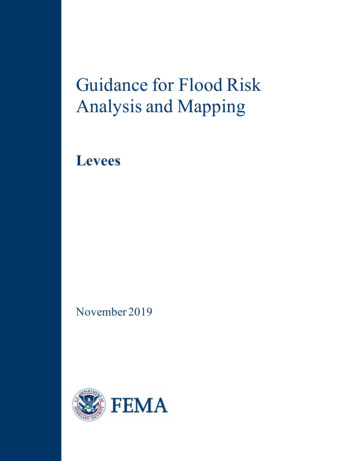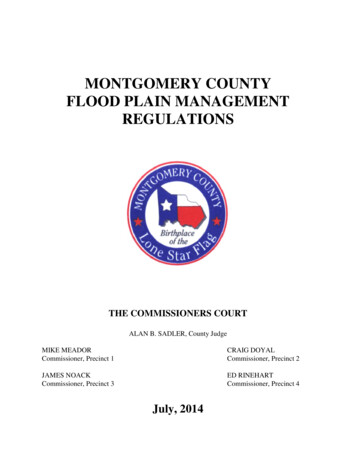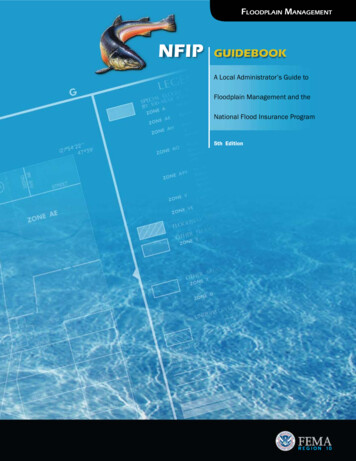
Transcription
Flood Risk Analysis and Mapping (Rev. 11)FEMA Policy #204-078-1BACKGROUNDThis policy is applicable to Federal Emergency Management Agency (FEMA) staff delivering Risk Analysis andMapping (Risk MAP), all mapping partners (contractors, cooperating technical partners, and other federalagencies) who perform flood risk projects on behalf of FEMA, and the National Flood Insurance Program(NFIP). Additionally, this policy may be pertinent to states, tribes, territories, local communities, homeownersand their consultants who are interested in the Flood Insurance Rate Map (FIRM) process.This policy updates and supersedes the Standards for Flood Risk Analysis and Mapping – FP 204-078-1(Rev 10) approved on Dec. 11, 2019.The changes with this revision are:Table 1: 2020 Maintenance Cycle: Standard UpdatesStandard Identification Number (SIDs)Standards Change DescriptionSIDs 66, 69, 73, 75, 77, 78, 79, 128, 248, 335Updating to include edits and refinements associatedwith the 2D Floodway Significant Update.SIDs 89, 96Updating to clarify the use of regulatory products andthe applicability of this standard.SID 99Rescinding standard in association with edits andrefinements associated with the 2D FloodwaySignificant Update.SIDs 101, 103, 229, 232, 256, 265, 274, 507Updating to clarify standard and align to currentstandard operating procedures.SID 230Rescinding standard because this is covered by otherstandards and guidance.SID 235Updating to comply with current style guidespecifications.SIDs 264, 272, 279, 280Updating to incorporate clarifications or corrections inthe wording of the standard.SID 415Updated to removed confusing language andemphasize the focus on quality.Page 1
Standard Identification Number (SIDs)Standards Change DescriptionSID 417Align the Standard to current standard operatingprocedures regarding automated creation of ChangesSince Last Firm (CSLF).SID 424Rescinding standard because the tiling structure is nolonger applicable.SID 443Updating to direct information on National FloodInsurance Program policy and claims information toOpenFEMA.SID 628Updating to reflect the automated creation of ChangesSince Last Firm (CSLF) through Customer and DataServices (CDS) tools and removes it from the list ofproducts required to align with model information.SID 630Updating to establish understanding that AutomatedMap Production (AMP) output products will lookdifferent than current requirements, but that is ok.Quality control (QC) will still be required for theengineering and flood hazard information.SID 640To keep Risk MAP IT systems secure and appropriatelyprotect the privacy of individuals who are referenced inRisk MAP data, a User Account Management Plan isbeing established so that all Risk MAP Providersunderstand the protocols that must be followed andmanaged.SID 641Updating as expired Provisionally Accredited Levee(PALs) are emerging issues and HQ requires moreoversight on the use of an expired PAL on an updatedregulatory product.SID 642Updating because seclusion should no longer be usedfor a Risk MAP study unless a specific case or set ofcircumstances dictates its use.SID 643New standard developed to address Coastal ZoneManagement Act (CZMA) consistency determinationrequirementsPURPOSEThe purpose of this policy is to enable consistent performance by identifying the standards that must befollowed in the delivery of the Risk Mapping, Assessment, and Planning (Risk MAP) program. Thesestandards govern the performance of flood risk projects, processing of letters of map change and relatedRisk MAP activities.Page 2
PRINCIPLES1.Ensure consistency in the deliverables of all flood risk projects so that they can support the NFIP and allits stakeholders.2. Ensure a standard level of quality is met for all deliverables of a flood risk project.3. Provide appropriate flexibility to FEMA Regional Offices and mapping partners to accommodate regionaland local variability across the country.4. Enhance the credibility of the NFIP and all flood risk mapping efforts.REQUIREMENTSFlood risk projects, regulatory NFIP map changes and other Risk MAP activities shall be performed in aconsistent manner resulting in quality data and deliverables. The attached set of standards shall be followedin the delivery of Risk MAP.Standards must be implemented based on the effective date and implementation description. Theimplementation description is chosen to avoid cost or scope impacts on existing task orders, cooperativeagreements, or interagency agreements. If the implementation of a new standard as mandated by this policyrequires a change to an existing agreement, coordinate with FEMA to modify the existing agreement asnecessary. New standards may be implemented sooner in coordination with the FEMA Project Officer andContracting Officer’s Representative.FEMA publishes substantial additional guidance to support implementation of and compliance with thesestandards. Users of these standards should also reference this guidance published on FEMA’s web site emas-risk-mapping-assessment-and-planning.This page was digitally signed by Nicholas Shufroon 2020.12.22.Nick ShufroActing Assistant AdministratorRisk Management Directorate, ResilienceDatePage 3
ADDITIONAL INFORMATIONReview CycleFEMA POLICY Standards for Flood Risk Analysis and Mapping #FP 204-078-1 (Rev. 11) will be reviewed, reissued,revised, or rescinded annually.AuthoritiesThe mapping program for the NFIP, implemented through Risk MAP, is established through the National FloodInsurance Act of 1968, as amended and the Biggert-Waters Flood Insurance Reform Act of 2012 (BW-12), asamended (42 U.S.C. 4001 et seq.). The mapping program is governed by the implementing regulations at Code ofFederal Regulations - Title 44 (44 CFR) parts 59-72. The statutes and regulations establish the core requirementsfor the mapping program.This policy represents FEMA’s interpretation of these statutory and regulatory requirements and/or sets forthstandard operating procedures. The policy itself does not impose legally enforceable rights and obligations but setsforth a standard operating procedure or agency practice that FEMA employees and contractors follow to beconsistent, fair, and equitable in the implementation of the agency’s authorities.These standards are to be applied in addition to the legal requirements set out in the applicable statutes andregulations. For the most part, the applicable statutory and regulatory requirements are not repeated in this policy.Readers must refer to the statutes and regulations in addition to these standards.DefinitionsFlood risk projects are projects implemented under the Risk MAP program to engage with communities and provideflood risk information.Guidance is a recommended method to meet the standard. Guidance assumes a working knowledge of commonindustry terminology and methodologies. Accepted approaches are not limited to this recommended approach;mapping partners may use other methods to meet or exceed the standard.Guidelines and Standards Steering Committee is comprised of FEMA headquarters and regional employees andcontractors responsible for maintenance and coordination of Risk MAP standards and guidance.Mapping Partners are FEMA Production and Technical Services Contractors, Cooperating Technical Partners, andOther Federal Agencies (OFA) performing tasks on a flood risk project.Program standards are a required element that supports the vision, goals and objectives of the program. Exceptionsmust be obtained through coordination with FEMA headquarters Risk Analysis Division leadership.Page 4
Risk MAP is the FEMA program that maintains flood maps for the NFIP and works with local governments to increaseawareness of flood risk and provide flood risk information that leads to actions to reduce risk.Standards exceptions are project-specific variances to Risk MAP standards, approved by appropriate Risk MAPofficials.Working standards are required elements of a project that are typically applied by specialists (such as engineers,planners, GIS specialists, etc.).Monitoring and EvaluationCompliance will be monitored through the Risk MAP Quality Assurance Management Plan.QuestionsDirect questions by email to the shared FEMA RMD Guidance & Standards inbox.Page 5
Appendix AAcronyms and Abbreviations Used in the Risk MAP Standards2DTwo-DimensionalAoMIAreas of Mitigation InterestBFEBase Flood ElevationBW-12Biggert-Waters Flood Insurance Reform Act of 2012CBRSCoastal Barrier Resources SystemCCOConsultation Coordination OfficerCDSCustomer and Data ServicesCEOChief Executive OfficerCFRCode of Federal RegulationsCIDCommunity IdentifierCISCommunity Information SystemCLOMAConditional Letter of Map AmendmentCLOMRConditional Letter of Map RevisionCLOMR-FConditional Letter of Map Revision based on FillCNMSCoordinated Needs Management StrategyCRSCommunity Rating SystemCSLFChanges Since Last FIRMCTPCooperating Technical PartnerCVAConsolidated Vertical AccuracyPage 6
DBFDatabase FileDEMDigital Elevation ModelDFIRMDigital Flood Insurance Rate MapDVTDatabase Verification ToolESRIEnvironmental Systems Research InstituteETJExtraterritorial JurisdictionFBFMFlood Boundary and Floodway MapFBSFloodplain Boundary StandardFDTFloodway Data TableFEDDFlood Elevation Determination DocketFEMAFederal Emergency Management AgencyFHBMFlood Hazard Boundary MapFHDFlood Hazard DeterminationFIRMFlood Insurance Rate MapFISFlood Insurance StudyFRDFlood Risk DatabaseFRMFlood Risk MapFRRFlood Risk ReportFVAFundamental Vertical AccuracyFWSU.S. Fish & Wildlife ServiceGCSGeographic Coordinate SystemGISGeographic Information SystemPage 7
H&HHydrologic & HydraulicHFIAAHomeowner Flood Insurance Affordability Act of 2014HQHeadquartersHUCHydrologic Unit CodeKDPKey Decision PointLFDLetter of Final DeterminationLIDARLight Detection and Ranging or Laser Imaging Detection and RangingLiMWALimit of Moderate Wave ActionLLPTLocal Levee Partnership TeamLODRLetter of Determination ReviewLOMALetter of Map AmendmentLOMCLetter of Map ChangeLOMRLetter of Map RevisionLOMR-FLetter of Map Revision based on FillMAF/TIGERMaster Address File/Topologically Integrated Geographic Encoding and ReferencingMIPMapping Information PlatformMSCMap Service CenterMXDArcMap Document (file extension)NAD83North American Datum 1983NAVD88North American Vertical Datum 1988NFHLNational Flood Hazard LayerNFIPNational Flood Insurance ProgramPage 8
NGONon-Governmental OrganizationNPSNominal Pulse SpacingNSRSNational Spatial Reference SystemNSSDANational Standard for Spatial Data AccuracyNTUNotice-to-UserNVANon-vegetated Vertical AccuracyNVUENew, Validated, or Updated EngineeringOFAOther Federal AgencyOPAOtherwise Protected AreasPALProvisionally Accredited LeveePDFPortable Document FormatPFDPrimary Frontal DunePLSSPublic Land Survey SystemPMRPhysical Map RevisionQAQuality AssuranceQA/QCQuality Assurance / Quality ControlQRQuality ReviewRAMRisk Analysis and ManagementRFHLRegional Flood Hazard LayerRPORegional Project OfficerSFHASpecial Flood Hazard AreaSHMOState Hazard Mitigation OfficerPage 9
SHPShapefile (file extension)SOMASummary of Map ActionsSOPStandard Operating ProcedureSRPScientific Resolution PanelSVASupplemental Vertical AccuracyTINTriangulated Irregular NetworkTSDNTechnical Support Data NotebookTWLTotal Water LevelUSGSUnited States Geological SurveyUTMUniversal Transverse MercatorVVAVegetated Vertical AccuracyWSELWater Surface ElevationXMLExtensible Markup Language (file extension)XSCross SectionPage 10
Appendix BStandards for Flood Risk Analysis and MappingTable 2: Standards for Flood Risk Analysis and MappingSID edCategoryStandardTypeStandardProgramStandardAll Flood Risk Projects and LOMCsmust be tracked in the MIP.WorkingStandardA Project Management Team shallbe formed as soon as a Flood RiskProject is initiated, and this teamshall manage the project for itsentire lifecycle.ProgramStandardWhen a community is initiallyconsidered for a Flood Risk Projectinvolving a new or revised floodhazard analysis, FEMA mustestablish and maintain a communitycase file per Code of FederalRegulations Title 44 CFR 66.3.Project InitiationProgramStandardAll newly initiated Flood RiskProjects must be watershed-based,except for coastal and small-scaleFlood Risk Projects related to leveeaccreditation status.Project PlanningProgramStandardNo flooding source will receive alower level of regulatory flood mapproduct than what currently existson effective maps.WorkingStandardBoth flood hazard validation andneeds assessment processes mustfollow the CNMS TechnicalReference and the results must bestored within the national CNMSdatabase.Project InitiationProject InitiationProject InitiationCNMSPage 11
SID andardWorkingStandardCommunity-specific requests toupdate the FIRM outside of theNVUE validation process and LOMRprocess must be documented in theCNMS database as mappingrequests for the FEMA Regionaloffice review and consideration.CNMSWorkingStandardThe CNMS database shall beupdated for engineering referenceinformation, validation status, andmap issues throughout all pertinentphases of the Flood Risk Project.CNMSProgramStandardThe CNMS database shall be thesole authority for reporting floodmap update needs.WorkingStandardFor a studied flooding source to gofrom ‘UNVERIFIED’ to ‘“VALID”status within the CNMS database,the flooding source must be reanalyzed.CNMSWorkingStandardWhen the last assessment date ofthe Modernized or Paper Inventoryexceeds five years, the ValidationStatus shall be changed by FEMAHeadquarters (HQ) or its designeeto ‘Unknown’ and shall requirereassessment.Project PlanningProgramStandardEach fiscal year, the regions shallhave a plan to evaluate all CNMSflooding sources within a 5-yearperiod.CNMSWorkingStandardNVUE status must be reported byeach FEMA Region to FEMA HQ atleast quarterly.Project PlanningWorkingStandardRegional decisions to prioritize,assess, and perform engineeringanalyses along various floodingCNMSCNMSPage 12
SID ndardTypeAlreadyimplementedsources must be supported by thedata contained in CNMS.WorkingStandardFEMA shall provide technical andprogrammatic assistance andprepare responses to inquiriesreceived from Mapping Partners,NFIP constituents and otherinterested project stakeholders.ProgramStandardEach flooding source must beevaluated in CNMS at least oncewithin a 5-year period.WorkingStandardDiscovery is a mandatory element ofall Flood Risk Projects. Allwatershed- based Discovery mustbe initiated at a geographic footprintthat encompasses the hydrologiccharacteristics of the area ofinterest. At the start of discovery,the delivery may be scaled toengage the appropriate level ofproject stakeholders based oncommunity need and risk.StakeholderEngagementWorkingStandardAll communities and tribes must begiven an opportunity to review andmake corrections to any data andinformation collected duringDiscovery prior to distribution offinal Discovery products.StakeholderEngagementWorkingStandardFlood Risk Project stakeholdersmust be contacted prior to theDiscovery Meeting.WorkingStandardDiscovery must engage allcommunities and the appropriatelevel of project stakeholdersidentified within the project areaand must engage practitionersacross relevant elyStandardCoordinationProject PlanningProject PlanningStakeholderEngagementPage 13
SID Implementedwith all newflood riskprojects initiatedin Fiscal ntedwith all newflood riskTypeStandardWorkingStandardThe types of data and informationobtained during Discovery mustdemonstrate a holistic picture offlooding issues, flood risk, and floodmitigation priorities, opportunities,efforts and capabilities.ProgramStandardDecisions to perform additionalanalyses, data developmentactivities, and/or communityengagement within the Flood RiskProject area must be supported bythe outcomes from Discovery. Thesedecisions shall be communicated toproject stakeholders prior toexecuting those ed data thatincorporates appropriatebackground research must beprovided to the communities andtribes prior to the Discovery Meetingand presented at the DiscoveryMeeting to facilitate discussions.DiscoveryWorkingStandardA Discovery Report and associateddata will be provided to thecommunities and tribes after theDiscovery Meeting.DiscoveryProject ryDiscoveryPage 14WorkingStandardA Discovery Report must include asection listing the data andinformation collected, when theywere received, data sources, and ananalysis of the data andinformation. It must also include theoutcomes and decisions made atthe Discovery Meeting.ProgramStandardA Discovery Meeting with projectstakeholders is a required activity ofDiscovery.ProgramStandardDuring Discovery, data must beidentified that illustrates potentialchanges in flood elevation and
SID ndardTypeprojects initiatedin Fiscal ngstandardAlreadyimplementedStandardmapping that may result from theproposed project scope. If availabledata does not clearly illustrate thelikely changes, an analysis isrequired that estimates the likelychanges. This data and anyassociated analyses must beshared and results must bediscussed with he Flood Risk Project scope ofwork must be developed incoordination with projectstakeholders.The purchased Flood Risk Projectscope of work must be shared withproject e 15WorkingStandardDiscovery must include a discussionwith stakeholders regarding riskidentification, mitigation capabilitiesand actions, planning, and riskcommunication.WorkingStandardFor coastal Flood Risk Projects thatwill begin with a storm surgeanalysis, stakeholder coordinationmust occur by the end of the stormsurge study effort and continuethroughout the remainder of thecoastal Flood Risk Project.WorkingStandardWhen storm surge analyses areincluded in a Flood Risk Project,Discovery efforts must include adiscussion of how storm surgeestimates have changed since theeffective Flood Risk Project.WorkingStandardThe FEMA Regional Office must beconsulted as to how tribal nationsshould be included in the overallDiscovery efforts.
SID mentStrategy (CNMS)StandardTypeProgramStandardStandardA Coordinated Needs ManagementStrategy (CNMS) database that iscompliant with Key Decision Point(KDP) questionnaires and the CNMSTechnical Reference must beupdated and submitted at thecompletion of Discovery, at ProjectInitiation, at Preliminary Issuance,at Revised Preliminary Issuance (ifapplicable), and at Letter of FinalDetermination Issuance (LFD).The CNMS database should also beupdated during post-effectivephases: at Letter of Map Revision(LOMR) effective date (if applicable),and for the 5- Year /20035/31/2016All Fiscal Year2016 taskorders thatinclude new xistingstandardAlreadyimplementedImplemented forall projects thathave not yetbegun datadevelopmentProgramStandardNew elevation data purchased byFEMA must comply with the currentUSGS National Geospatial ProgramBase Lidar Specification Version1.2, except hydro-flattening is notrequired and a classified point cloudand a bare earth DEM deliverableare not required.Elevation DataWorkingStandardFor areas within the continentalUnited States field surveys andaerial data acquisition must bereferenced to the North AmericanVertical Datum of 1988 (NAVD88)and the North American Datum1983 (NAD83) and connected tothe NSRS.Elevation DataWorkingStandardAll ground and structure surveysmust be certified by a registeredprofessional engineer or a licensedland surveyor.WorkingStandardAll updated flood hazard datashown on the Flood Insurance RateMap (FIRM), in the FIRM Databaseand Flood Insurance Study (FIS)must be based on the mostElevation DataElevation DataPage 16
SID ndardTypeStandardaccurate existing topographic dataavailable to FEMA before the startof data development and the datamust have documentation that itmeets the following verticalaccuracy requirements:If data is not available that meetsthese requirements, new elevationdata must be obtained. (Refer toFigure 1 on page standardAlreadyimplementedAll Fiscal Year2016 taskorders thatinclude new mplementedwith all newflood riskprojects initiatedElevation DataWorkingStandardFEMA requires all elevation data tobe processed to the bare earthterrain in the vicinity of floodplainsthat will require hydraulic modeling.Elevation DataWorkingStandardFEMA does not require the elevationdata to be hydro-flattened, asspecified in USGS LidarSpecification.Elevation DataWorkingStandardWhen a classified point cloud and aDigital Elevation Model (DEM)deliverable are included in a newelevation data collection,checkpoints for Vegetated VerticalAccuracy (VVA) must fall within theDEM footprint.Elevation DataWorkingStandardAll FEMA-funded aerial mappingmust be certified by a licensedprofessional or certifiedphotogrammetrist.H&H AnalysesWorkingStandardWhere flood elevations areproduced from a hydraulic model,they can be published as BFEsunless the responsible engineerPage 17
SID ypeStandardin FiscalYear2013documents why they should not beissued.Implementedwith all newflood riskprojects initiatedin FiscalYear2013Written approval from the FEMARegional Risk Analysis Branch Chiefregarding the alluvial fanmethodology must be obtainedbefore the commencement of fullanalysis. To inform this decision,sufficient field data and analysisand records of communityengagement relative to the scopeand methodology must be implementedAlluvial FanEngineeringProgramStandardProgramStandardThe regulatory products and nonregulatory flood risk products mustbe based on H&H or coastalanalyses using existing groundconditions in the watershed andfloodplain. The multiple profile andfloodway runs must have the samephysical characteristics in commonfor existing ground conditions.However, a community may chooseto include flood hazard informationthat is based on future conditionson a FIRM (shown as shaded ZoneX); in an FIS Report; or nonregulatory flood risk products inaddition to the existing- conditions.H&H AnalysesEngineeringPage 18WorkingStandardHydrologic and hydraulic analysesmust be calibrated using data fromwell- documented flood events, ifavailable.ProgramStandardEngineering analyses must bedocumented and easily reproducibleand must include study methods,reasoning for method selection,input data and parameters, sourcesof data results, and justifications formajor changes in computed floodhazard parameters.
SID andardAlreadyimplemented7111/30/2019For all projectswhere theengineeringwork has not H AnalysesBase FloodElevations(BFEs)Flood ProfilesFloodwayFloodwayFloodwayFloodwayPage 19StandardTypeStandardProgramStandardNew or updated flood hazard dataused for the regulatory productsmust be supported by modelingand/or sound engineeringjudgment. All regulatory productsmust be in agreement.WorkingStandardBFEs must agree with those of othercontiguous studies of the sameflooding source within 0.5 foot,unless it is demonstrated that itwould not be appropriate. Pleasesee 44 C.F.R. § 65.6(a)(2).WorkingStandardEach significant split or divertedflow path modeled in 1D andmapped as Zone AE or AH must beplotted with individual FloodProfiles.ProgramStandardFloodway surcharge values must beless than or equal to 1.0 foot. If thestate (or other jurisdiction) hasestablished more stringentregulations, these regulations takeprecedence over the NFIP regulatorystandard. Further reduction ofmaximum allowable surchargelimits can be used if required orrequested and approved by thecommunities impacted.WorkingStandardIf a stream forms the boundarybetween two or more states and/ortribes, either the 1.0-foot maximumallowable rise criterion or existingfloodway agreements between theparties shall be used.WorkingStandardNew or revised floodway data mustmatch any effective floodways atthe limits of the Flood Risk Project.WorkingStandardA methodology based on equitableconsideration of both overbanks
SID ndardTypeStandardmust be used to establish theminimal regulatory floodway.Variations to this approach must bemade in coordination with FEMAand the impacted he hydrologic, hydraulic, andcoastal analyses and the publishedregulatory products must becertified by a registered professionalengineer.FIS TablesWorkingStandardFor each stream where a floodwaywas determined under the scope ofwork, a Floodway Data Tablecompliant with the FIS ReportTechnical Reference must beprepared as part of the hydraulicanalysis. The Floodway Data Tablemust contain an entry for eachlettered, mapped cross section orevaluation line and must include theinformation outlined in the FISReport Technical Reference.H&H AnalysesWorkingStandardIf previously-modeled storage areasare removed or filled, the modelsmust be updated to reflect the lossin storage.WorkingStandardFloodway computations fortributaries must be developedwithout consideration of backwaterfrom confluences unless acoincident frequency analysis ordetailed historical observationsprove otherwise. If either of theseexceptions is used, it must be donein coordination with FEMA.WorkingStandardThe water-surface profiles ofdifferent flood frequencies modeledin 1D must not cross one another,unless technical justification isprovided in coordination with FEMA.H&H AnalysesFloodwayFlood ProfilesPage 20
SID lreadyimplementedImplementedwith all newflood riskprojects initiatedin FiscalYear2013CategoryFlood ProfilesProfile BaselineProjectManagementProject PlanningH&H AnalysesPage 21StandardTypeStandardWorkingStandardWater-surface elevations shown onthe Flood Profiles for 1D modelsshall not rise from an upstream todownstream direction, unlesstechnical justification is provided incoordination with FEMA.WorkingStandardIf a flow path other than the streamcenterline is more representative ofthe direction of flow, the case mustbe documented and the flow pathshown and labeled on the FIRM asthe "Profile Baseline". Flowdistances in one- dimensionalmodels must be referenced to theprofile baseline.ProgramStandardFinal invoices shall not be paid untila TSDN is submitted, andcertification is provided thatcontract or grant requirements aremet.ProgramStandardThe FEMA Regional staff initiating aFlood Risk Project shall first engageall stakeholders in order to fullyunderstand the impactedcommunities, leverage other FEMAactivities in the area, and therebyavoid duplication of benefitsthrough funding to CooperatingTechnical Partners.ProgramStandard All riverine engineering FloodRisk Projects shall consist of ahydraulic model with multiplefrequencies: 0.2-percent, 1percent, 2-percent, 4-percent,and 10-percent-annual-chanceexceedance events. In addition, the “1-percent plus”flood elevation shall be modeledfor all riverine analyses. The 1percent plus flood elevation isdefined as a flood elevationderived by using discharges that
SID ndardTypeStandardinclude the average predictiveerror for the regression equationdischarge calculation for theFlood Risk Project. This error isthen added to the 1-percentannual chance d
Mapping (Risk MAP), all mapping partners (contractors, cooperating technical partners, and other federal agencies) who perform flood risk projects on behalf of FEMA, and the National Flood Insurance Program (NFIP). Additionally, this policy may be pertinent to states, tribes, territories, local communities, homeowners
